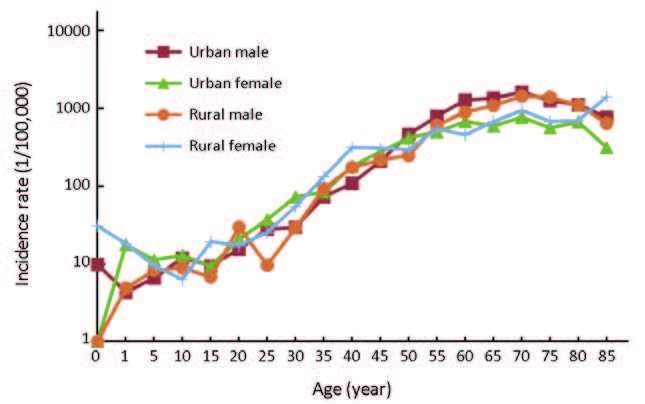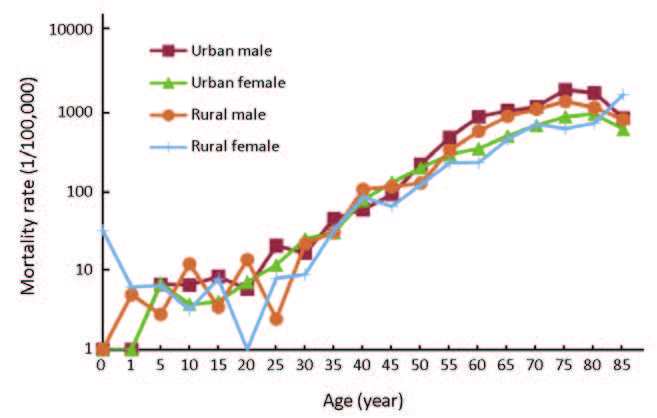Cancer incidence and mortality in Gansu province, 2012
Yuqin Liu, Xiaodong Zhang, Lili Chen, Qin Zhao, Xiaojun Xia
Abstract
Objective: Population-based cancer registration data in 2012 from all available cancer registries in Gansu province were collected by the Central Cancer Registry of Gansu. The numbers of new cancer cases and cancer deaths in Gansu province with compiled cancer incidence and mortality rates were estimated.
Methods: In 2015, data from 7 registries in Gansu province were qualified. The pooled data were stratified by area (urban/rural), gender, age group (0, 1.4, 5.9, 10.14, …, 85+) and cancer type. New cancer cases and deaths were estimated using age-specific rates and corresponding population of Gansu province in 2012. The Chinese census data in 2000 and Segi’s population were applied for age-standardized rates. All the rates were expressed per 100,000 person-years.
Results: Qualified 7 cancer registries (3 urban and 4 rural registries) covered 2,956,560 populations of Gansu province in 2012. The percentage of cases morphologically verified (MV%) and death certificate-only cases (DCO%) were 72.41% and 1.65%, respectively, and the mortality to incidence rate ratio (M/I) was 0.63. It was estimated that there were 575,600 new cancer cases and 331,300 cancer deaths in Gansu province in 2012. The incidence rate was 223.29/100,000 (244.14/100,000 in males and 201.50/100,000 in females), the age-standardized incidence rates by Chinese standard population (ASIRC) and by world standard population (ASIRW) were 208.95/100,000 and 206.41/100,000 with the cumulative incidence rate (0.74 years old) of 22.49%. The crude incidence rate in urban areas was equal to that in rural areas. However, after adjusted by age, the cancer incidence rate in urban was the same as that of rural areas. The crude mortality in Gansu province was 128.54/100,000 (135.04/100,000 in males and 124.43/100,000 in females), the age-standardized mortality rates by Chinese standard population (ASMRC) and by world standard population (ASMRW) were 109.54/100,000 and 108.44/100,000, respectively, and the cumulative mortality rate (0.74 years old) was 12.91%. The crude cancer mortality rate in urban areas was higher than that of rural areas. However, the agestandardized rate in urban areas was the same as that of rural areas. Cancers of stomach, liver, lung, esophagus, female breast, colorectum, cervix, brain, pancreas and ovary were the most common cancers, accounting for about 83.56% of all cancer new cases. Stomach cancer, liver cancer, lung cancer, esophageal cancer, female breast cancer, colorectal cancer, brain cancer, lymphoma, pancreatic cancer and cervix cancer were the leading causes of cancer death, accounting for about 85.58% of all cancer deaths. The burden between urban and rural, males and females was different.
Conclusions: Registration data of Gansu province were qualified to provide basic information on population-based cancer incidence, mortality for cancer prevention and control. The digestive tract cancer burden in Gansu province, especially for males in rural areas, was higher. The incidence rate of female breast cancer was higher in urban areas. Targeted prevention, early detection and treatment programs should be carried out by health department to control the cancer burden.
Keywords: Cancer registry; incidence; mortality; epidemiology; Gansu province
Submitted Apr 06, 2016. Accepted for publication Apr 29, 2016.
doi: 10.21147/j.issn.1000-9604.2016.03.04
Introduction
The National Central Cancer Registry (NCCR) of China estimated that there were 4,292,000 new cases of cancer diagnosed in 2015 in Gansu province, China (1). Since 2012, Central Cancer Registry of Gansu began publishing cancer registry annual report. The cancer registration data are very useful in the prevention and control of cancer through estimating the local cancer incidence and mortality. In this paper, we provide a comprehensive overview of cancer incidence and mortality rates, and estimate new cancer cases and cancer deaths in Gansu province in 2012.
Materials and methods
Data source
The Central Cancer Registry of Gansu is in charge of population-based cancer registry in Gansu province with responsibility of system establishment, training, data collection, evaluation and publication of annual report. The incidence cases were reported to cancer registries from local hospitals, community health service centers, the Basic Medical Insurances for Urban Residents and the New-Rural Cooperative Medical System. Seven cancer registries in Gansu province submitted 2012 data to Central Cancer Registry of Gansu. All cancer cases were classified according to the International Classification of Diseases for Oncology, 3rd edition (ICDO- 3) and the International Statistical Classification of Diseases and Related Health Problems 10th Revision (ICD-10). Finally, all submitted data were pooled to form the database of Gansu provincial registry system in 2012.
Population of Gansu province estimates
The population of Gansu province in 2012 was estimated based on the fifth National Census data (2000) provided by the National Statistics Bureau of China, taking into account of the changes of age composition, gender ratio and the proportion of urban and rural transformation released by the National Bureau of Statistics (http://data.stats.gov.cn/). The population of Gansu province in 2012 was stratified by area (urban/rural), gender (male/female) and age groups (0-,1-4,5-84 by 5 years, 85+ years). The age-specific death probability was adjusted referring to the Sixth National Census in 2010. Linear changes were assumed in each age group between the fifth and sixth Population Census.
Quality control
The Central Cancer Registry of Gansu checked and evaluated the quality and comparability of submitted data based on "Guideline for Chinese Cancer Registration", referring to relevant data quality criterion of "Cancer Incidence in Five Continents Volume IX" by International Agency for Research on Cancer/International Association of Cancer Registries (IARC/IACR) (2). The data included in the final analysis should meet the following criteria: the percentage of cases morphologically verified (MV%) was not lower than 66%; the percentage of death certificate-only cases (DCO%) was lower than 15%; the mortality to incidence ratio (M/I) was between 0.6 and 0.8; and the percentage of the diagnosis of unknown basis (UB%) was lower than 5%.
Statistical analysis
Incidence and mortality rates were calculated by area, gender and age groups. The numbers of new cases and deaths were estimated using the 5-year age-specific cancer incidence/ mortality rates and the corresponding populations. The Chinese population in 2000 and World Segi’s population were used for age-standardized rates. The cumulative risk of developing or dying from cancer before 75 years of age (in the absence of competing causes of death) was calculated and presented as a percentage. Software including MS-Excel and IARCcrg Tools 2.05 issued by IARC and IACR was used for data checking and evaluation (3). SAS software (SAS Institute Inc., Cary, USA) was used to calculate the incidence and mortality rates.
Results
Data quality
There were 7 registries in Gansu province accepted by this analysis, including 3 cities and 4 counties, and covering 2,956,560 of populations, including 1,523,503 males and 1,433,057 females, accounted for 11.47% of population of Gansu province in the end of 2012.
The overall indicators of MV%, DCO% and M/I ratio were 72.41%,1.65% and 0.61, respectively. They were 75.22%,0.40% and 0.63 in urban registries, compared to 62.94%,5.88% and 0.54 in rural. The quality evaluation for major cancers is presented in Table 1.
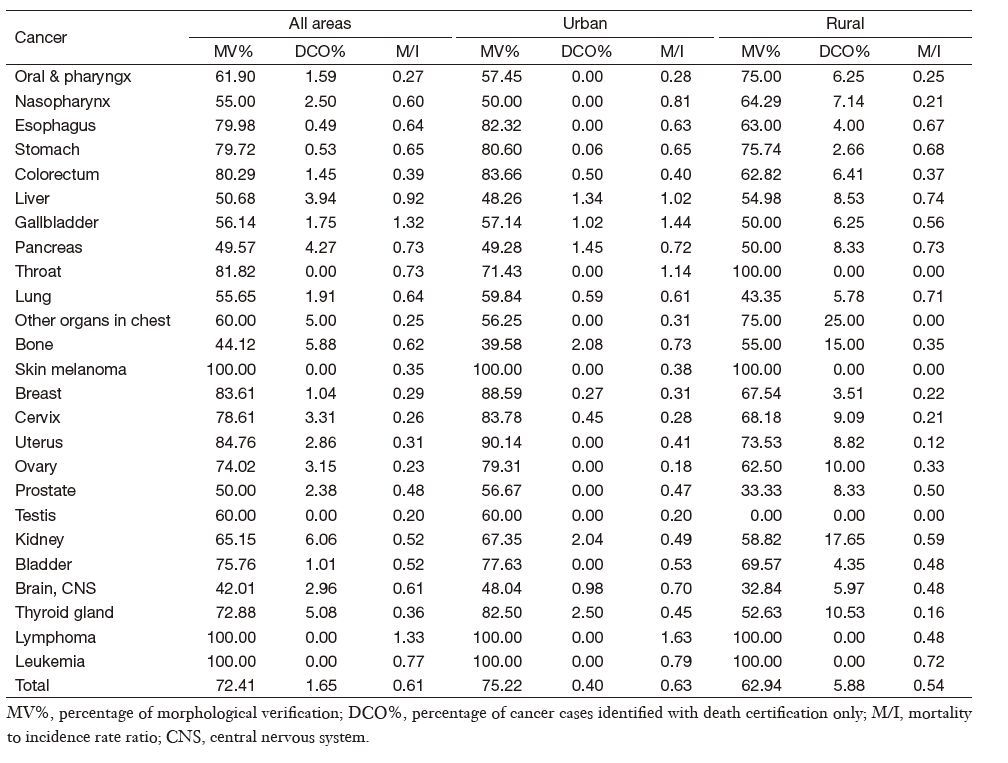
Full table
Incidence and mortality of overall cancers
Incidence
It was estimated that there were 575,600 new cases diagnosed as cancer in Gansu province in 2012. The crude incidence rate of all cancers was 223.29/100,000 (244.14/100,000 in males and 201.50/100,000 in females). The age-standardized incidence rates by Chinese standard population (ASIRC) and by world standard population (ASIRW) were 187.78/100,000 and 185.41/100,000, respectively. Among the cancer patients aged 0-74 years, the cumulative incidence rate was 22.49%. The crude incidence rate in rural areas was higher than that in urban areas. However, after adjusted by age, the cancer incidence rate in urban was higher than that in rural areas (Table 2).
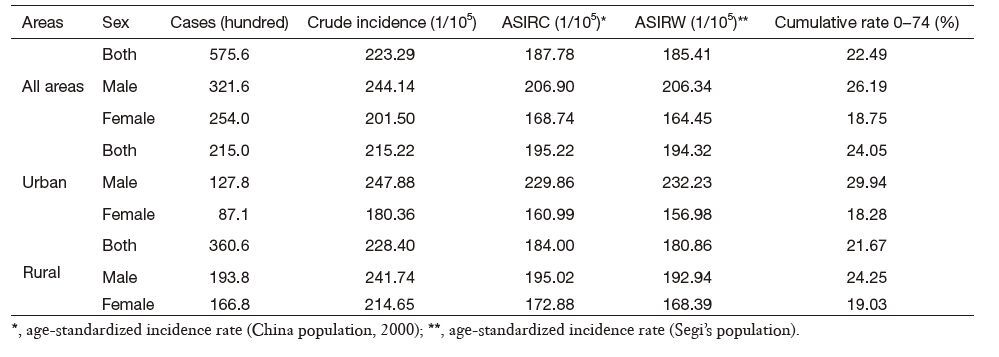
Full table
Age-specific incidence rate
The age-specific incidence rate was relatively lower before 35 years old, then increased dramatically and peaked at age group of 70-74 years. The pattern was similar between urban and rural areas. Comparing the age-specific incidence rate between urban and rural areas, except age of 25-39,50-79 and 80+years, urban areas had lower incidence rates than rural areas (Table 3, Figure 1).
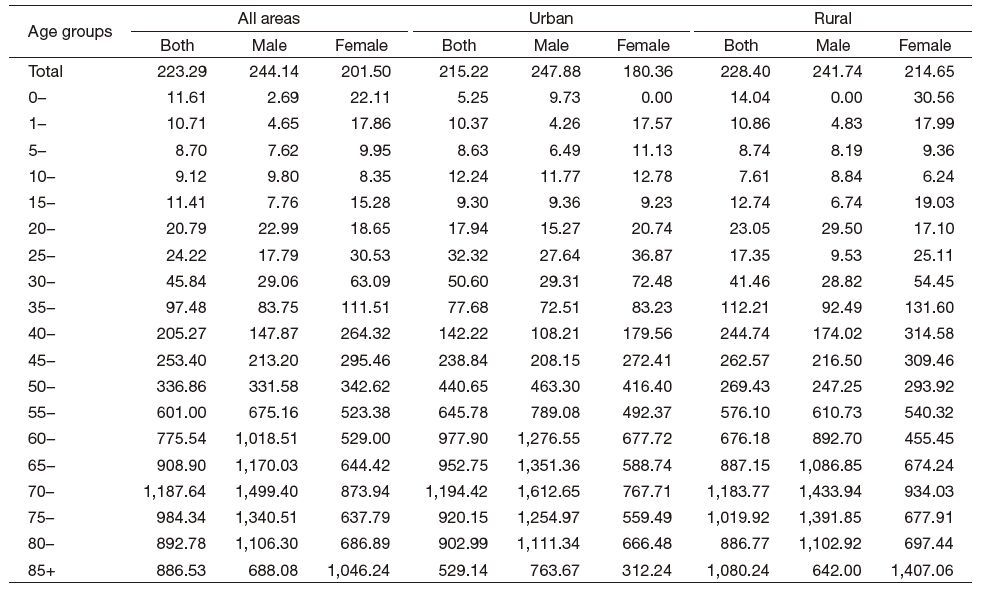
Full table
Mortality
It was estimated that there were 33,130 people died from cancer in Gansu province in 2012. The crude mortality of all cancers in Gansu province was 128.54/100,000 (156.55/100,000 in males and 99.27/100,000 in females). The age-standardized mortality rates by Chinese standard population (ASMRC) andby world standard population (ASMRW) were 109.24/100,000 and 108.44/100,000, respectively. Among the patients aged 0-74 years, the cumulative mortality rate was 12.91%. The crude cancer mortality rate and age-standardized rate in urban areas were higher than that in rural areas (Table 4).
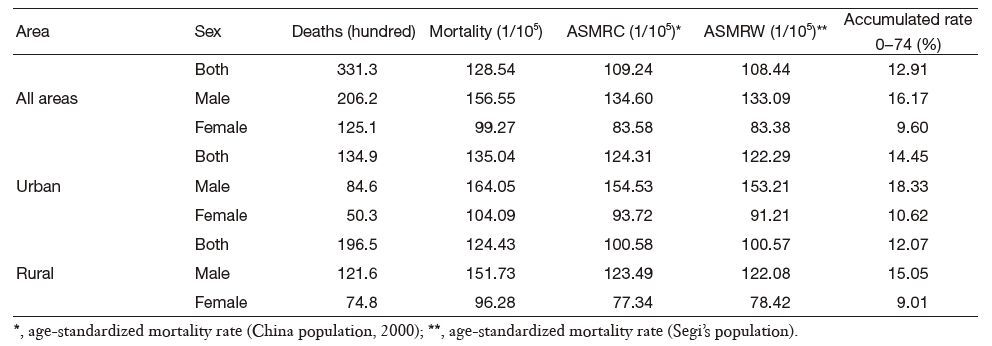
Full table
Age-specific mortality
The age-specific mortality rate was relatively lower before 45 years and then dramatically increased, reaching peak after 75 years (Table 5, Figure 2). The pattern was similar between urban and rural areas. Comparing the age-specific mortality rate between urban and rural areas, in most age groups under 70years, urban areas had higher mortality rates than rural areas.
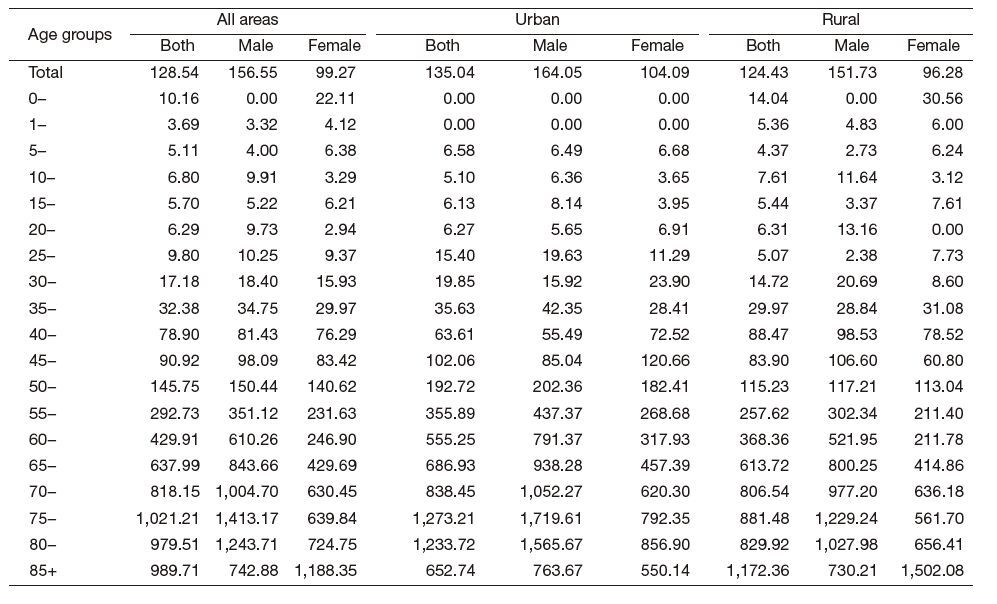
Full table
Incidence and mortality for major cancers
Cancer incidence for the 10 most common cancers
Stomach cancer was the most common cancer in all areas, followed by liver cancer, lung cancer, esophageal cancer and female breast cancer. With estimated new cases of 14,241,6,379,6,154,5,281 and 4,045, respectively. Stomach cancer was the most frequently diagnosed cancers in males, followed by liver cancer, lung cancer, esophageal cancer, and colorectal cancer. Female breast cancer was the most common cancers in females followed by stomach cancer, cervix cancer, lung cancer and liver cancer (Table 6).

Full table
Cancer death of the top 10 cancers
Stomach cancer was the leading cause of death in Gansu province followed by liver cancer, lung cancer, esophageal cancer and colorectal cancer with estimated deaths of 9,522,5167,4,180,3,392 and 1,309, respectively. In males, stomach cancer was the leading cause followed by liver cancer, lung cancer, esophageal cancer and colorectal cancer; while in females, stomach cancer was still the leading cause followed by lung cancer, liver cancer, breast cancer, and esophageal cancer (Table 7).

Full table
Cancer incidence of the 10 most common cancers in urban areas
In urban areas, stomach cancer was the most frequently diagnosed cancers, followed by esophageal cancer, lung cancer, colorectal cancer and female breast cancer with the estimated new cases of 6,227,2,894,2,058,1,648 and 1,529 respectively. The most common sites of cancer were stomach, esophagus, lung, liver and colorectum in males, while in females, cancers of breast, stomach, cervix, esophagus and colorectum were the most common cancers (Table 8).

Full table
Cancer death of the top 10 cancers in urban areas
Stomach cancer was the leading cause of cancer death in urban areas for both males and females with estimated number of deaths of 3,026 and 972, respectively. Other cancer types withhigh mortality in males were esophageal cancer, liver cancer, lung cancer and lymphoma. In females, esophageal cancer was the second cause of cancer death, followed by breast cancer, liver cancer and gallbladder cancer (Table 9).

Full table
Cancer incidence of the 10 most common cancers in rural areas
Stomach cancer was the most frequently diagnosed cancers with estimated new cases of 8,014 and incidence rate of 50.76/100,000, followed by liver cancer, lung cancer, cervix cancer and female breast cancer. The most common sites of cancer in males were stomach, liver, lung, esophagus and colorectum, while in females, they were cervix, breast, stomach, lung and liver (Table 10).

Full table
Cancer death of the top 10 cancers in rural areas
Stomach cancer was the leading cause of cancer death in rural areas for both males and females. The number of deaths on stomach cancer in rural were 5,524 with mortality of 34.99/100,000. The other cancer types with high mortality were liver cancer, lung cancer, esophageal cancer and pancreatic cancer in males; and lung cancer, liver cancer, breast cancer and cervix cancer in females (Table 11).
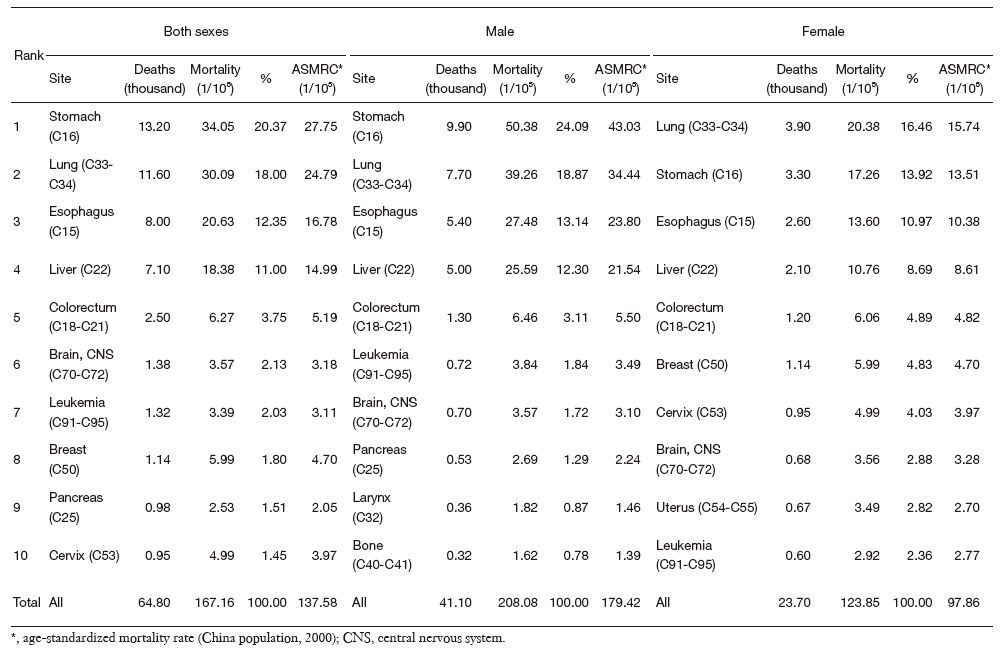
Full table
Discussion
Cancer registries in Gansu province collect information on cancer incidence cases and cancer deaths from covered population to monitor the cancer epidemics in local areas. The quality of the information was checked carefully by cancer registries in Gansu province. In 2015, all registries’ data in Gansu province were qualified for the national cancer registry annual report in 2012, covering 11.47% of population of Gansu province at the end of 2012.
The incidence and mortality rates in Gansu province were 223.29/100,000 and 128.54/100,000 in 2012, respectively. Compared with the updated data in China (4), Gansu province had higher cancer incidence and mortality rates. Stomach cancer was the most common cancer and the leading cause of death in Gansu province. Cancers of digestive organs are still the more common cancers and cancer deaths in Gansu province, accounting for 53.33% of all cancers. In China, the 5 most common sites of cancer are lung, stomach, liver, esophagus and colorectum in males, and breast, lung, colorectum, stomach and liver in females. The spectrum of cancers between Gansu province and China showed different ranks of stomach, lung, liver in males and different ranks of stomach, lung and cervix in females. In Gansu province, weshould give priority to cancers with poor results, and besides there was still one thing should be mentioned that cervix cancer stays in the top of incidence in rural areas. On this account, we should strengthen the knowledge of the prevention of cervix cancer in rural areas.
The incidence rate of all cancers in males was about 21.16% higher than that in females and the mortality rate was about 57.70% higher. In the top 10 cancers, the incidence rates of lung cancer, stomach cancer, esophageal cancer and liver cancer were over 55.69% higher in males. The reasons for the higher rates in males may be related to modifiable lifestyle and environmental risk factors like smoking, alcohol and so on (5-9).
As shown in our data, the incidence rate, mortality rate and cancer ranks were quite similar between urban and rural areas in Gansu province. However, the burden of digestive tract cancers was higher in rural areas (70.66%) than in urban areas (59.01%). The burden of female breast cancer in urban areas was higher, but in rural areas, cervix cancer was the burden.
Conclusions
Registration data of Gansu province were qualified to provide basic information on population-based cancer incidence, mortality for cancer prevention and control. The digestive tract cancer burden in Gansu province was higher. The incidence rate of female breast cancer was high in urban areas, while cervix cancer in rural areas was high. Therefore, targeted prevention, early detection and treatment programs should be carried out by health department to control the cancer burden.
Acknowledgements
We gratefully acknowledged the cooperation of all the population-based cancer registries in Gansu province for datacollection, sorting, verification and database creation.
Footnote
Conflicts of Interest: Conflict of Interest: The authors have no conflicts of interest to declare.
References
- Chen W, Zheng R, Baade PD, et al. Cancer statistics in China, 2015. CA Cancer J Clin, 2016;66 :115–132. [PubMed]
- Curado MP, Edwards B, Shin HR, et al. Cancer Incidence in Five Continents.Vol. IX. Lyon: IARC, 2008 : 1 -837.
- Ferlay J. The IARCcrg Tools Programs. Lyon: IARC, 2006 .
- Chen W, Zheng R, Zeng H, et al. Annual report on status of cancer in China, 2011. Chin J Cancer Res, 2015;27 :2–12. [PubMed]
- Fan JH, Wang JB, Jiang Y, et al. Attributable causes of liver cancer mortality and incidence in China. Asian Pac J Cancer Prev, 2013;14 :7251–7256. [PubMed]
- Wang JB, Fan JH, Liang H, et al. Attributable causes of esophageal cancer incidence and mortality in China. PLoS One, 2012;7 :e42281. [PubMed]
- Wang JB, Jiang Y, Liang H, et al. Attributable causes of cancer in China. Ann Oncol, 2012;23 :2983–2989. [PubMed]
- Liang H, Wang J, Xiao H, et al. Estimation of cancer incidence and mortality attributable to alcohol drinking in China. BMC Public Health, 2010;10 :730. [PubMed]
- Wang JB, Jiang Y, Wei WQ, et al. Estimation of cancer incidence and mortality attributable to smoking in China. Cancer Causes Control, 2010;21 :959–965. [PubMed]

